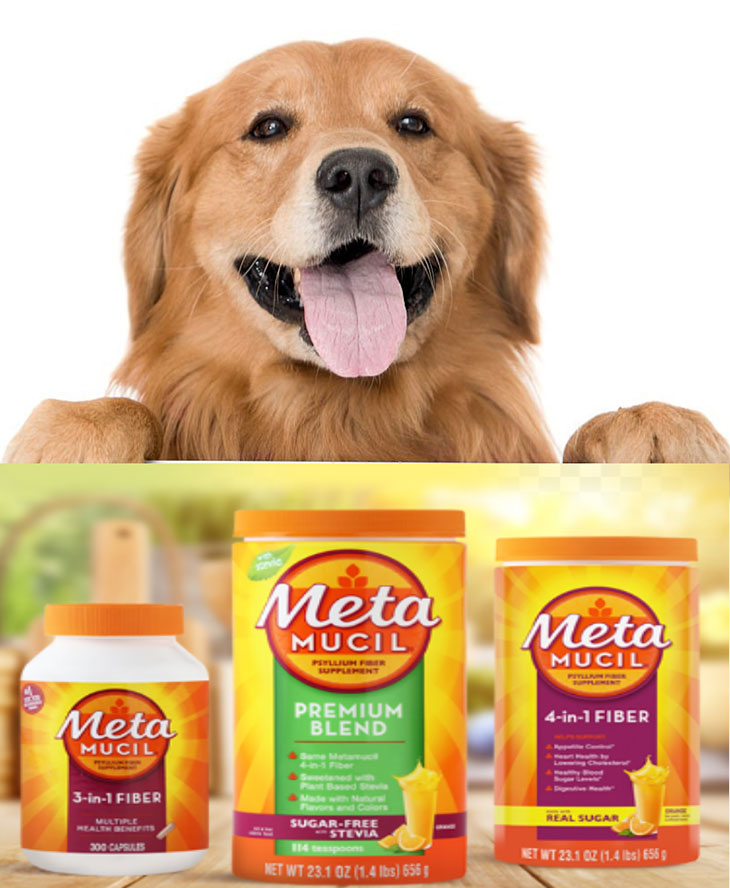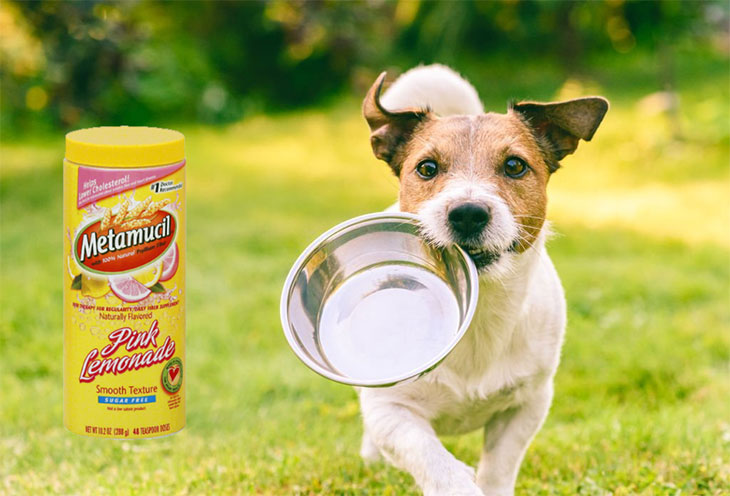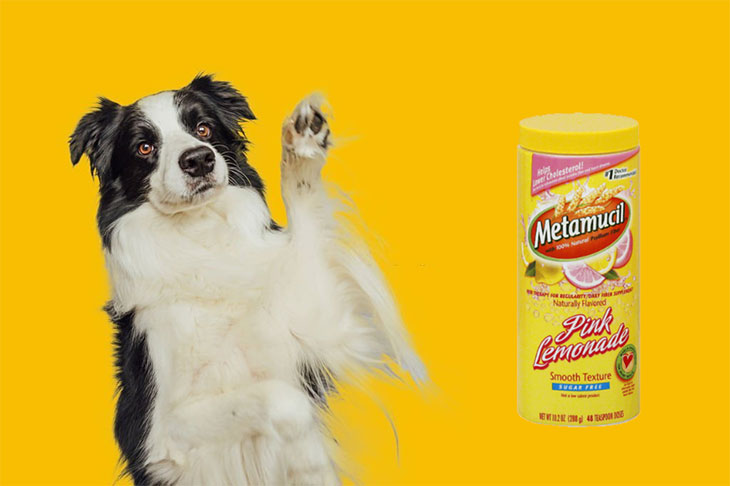Fiber is proven to improve blood flow and digestive systems for both humans and dogs.
That explains why many canine parents try to include fiber into their dogs’ daily treats – particularly through orange-flavored Metamucil.
Is Metamucil 100% harmless, though, and can I give my dog orange flavored Metamucil? Find the answer to these burning inquiries in my article.
What Is Orange Flavored Metamucil? Their Usage and Benefits For Dogs

Usage
Orange-flavored Metamucil is a dietary supplement that uses Psyllium (derived from Plantago ovata plants) as the main ingredient.
As one of the best viscous soluble fibers, Psyllium’s fermentability is undisputed – meaning it can easily dissolve in liquids to form gels.
From there, the fiber sticks around your GI tract instead of breaking down under the pressure of gut bacteria.
No wonder its gas production is impressively lower than any popular fermentable fiber type!
On another note, Metamucil also contains a small amount of insoluble fiber (not dissolving in water) to balance the supplement properties.
This delicate ratio makes Metamucil a common choice among dog parents seeking fiber addition.
In some medical situations, veterinarians may require Metamucil for your canine, too. A few dog owners may question this prescription due to Metamucil’s usual labels as “for humans.”
But no worries. Provided the treats are under proper supervision, they can do quite a lot in handling canine diseases – which we will discuss below.
Benefits
Relieving Constipation
Due to its bulk-forming laxative nature, Psyllium does an incredible job of relieving constipation and increasing the pet’s stool size.
More specifically, this supplement binds itself to the dog’s digested food throughout the way to the small intestine, adding moisture to ease stool absorption.
Treating Diarrhea
Like humans, diarrhea is, unfortunately, a very common case in dogs.
Let Metamucil lend a helping hand with this. The boosted water absorption adds moisture and thickens its density simultaneously, slowing the stool’s passage across the colon.
Your dog will recover in no time.
Remember to consult professional opinions first about what causes diarrhea for your pet in the first place. Confirm the correct dosage of Metamucil before giving it to your dog.
Prebiotic Effects
Aside from soluble and insoluble fibers, orange-flavored Metamucils incorporate prebiotics in their compounds, too.
This substance helps ferment the psyllium fibers into the pet’s intestines, creating numerous SCFA (short-chain fatty acids) that strengthens the dog’s well-being.
Other Benefits (Needing More Proof)
Many dog owners also insist on Metamucil’s ability to lower weight, blood sugar level, and cholesterol level.
Not many scientific studies back up these claims by the time of this writing, but the same effects have been found during experiments on humans.
The chances of them recurring in dogs are very likely, though at what level and how much dosage is still a question that needs answers.
Can I Give My Dog Orange Flavored Metamucil?

Yes. Overall, Metamucil is nutritional and delivers tons of health benefits. Given proper dosage and supervision, these fiber supplements will spice up your dog’s daily treatments in the best way.
Still, be aware that, like any dietary product, severe side effects and risks are not out of sight.
Any clash between the Metamucil and the dog’s eating preference/style/habit may lead to at least one of the following issues:
Gastrointestinal Upset
Orange-flavored Metamucils are not always palatable to several dog breeds, for once.
They often contain sugar (brown sugar, sucrose, etc., to boost the dog’s appetite), which leads to gastrointestinal upset.
As a result, your dogs will suffer from sporadic episodes of diarrhea and vomiting (ironic, we know, since Metamucils are supposed to treat diarrhea instead of causing it!).
The vomits often contain yellowish, foamy bile; some owners even observe gagging or dry heaving after the dog consumes the Metamucil.
In worse cases, the canine will have decreased appetites, become less active, and get tender when you pick it up around its abdomen, Low-grade fevers also hover on the horizon.
Vomiting
Vomiting may accompany gastrointestinal upset (as discussed above) or arrive by itself.
The symptoms start with a few nausea stages – in which your dog looks apprehensive and much more restless than usual once devouring the Metamucil.
It may salivate, lick its mouth, or swallow repeatedly. Worse, the forceful contractions within the abdominal muscles even lead to food and fluid expulsion.
If you and your dog are lucky, the vomiting should resolve without any medical intervention after 24 hours.
But for dogs that do not stop vomiting even after 1 or 2 days have passed, you must seek professional help immediately to see whether the Metamucil has caused them any severe metabolic disturbance.
Likewise, vomiting going with appetite loss, lethargy, fever, abdominal pain, dehydration, or blood requires emergency attention. Do not put it off.
Rectal Bleeding
“Rectal bleeding” points to the blood found in the dog’s stool or passed during bowel movements.
As it is more like a symptom than a specific diagnosis or specific condition, you will likely find rectal bleeding to go with other tell-tale indicators, such as vomiting, diarrhea, etc.
Its severity varies depending on the Metamucil type and your dog’s eating style. It can either be a few drops or significant blood amounts mixed onto the stool; there is no easy way to tell!
Treatments usually involve antibiotics, nausea/anti-vomiting medications, and aggressive hydration using IV (intravenous fluids). Your dog will likely need several hospitalization days, too.
Here is some good news: most canines recover from rectal bleeding uneventfully and resume normal activities in only a few days. You do not have to worry yourself more than necessary.
Severe Constipation
Can you give flavored Metamucil to dogs that are not getting used to the sudden dietary fiber change? No, as they may face severe constipation issues.
Most canines produce feces once per day (minimum), whose bowel movements correspond to the daily number of feedings.
Being constipated means they will struggle to pass fences, circle excessively, squat, drag their bottom around, or even cry out for help.
Other clinical signals of dogs with constipation include:
- Vomiting
- Decreased appetite
- Mucus in feces (without normal stools)
- Weight loss
- Plenty of water fences
- Painful, tense abdomen (the dog will growl or cry if you touch its lower back or stomach)
Bloating
Bloating is another danger lurking around orange-flavored Metamucil. The pet’s stomach starts expanding or distending, cutting off the blood circulation to the stomach and abdomen.
This sudden shutdown may cause injury to its stomach wall/other organs and put huge pressure on the diaphragms (thin muscles that separate the abdomen and chest).
Your dog will literally have to wrestle with each of its breathing.
All bloat cases demand immediate medical support to assess the severity – and can be cured if receiving on-time treatment.
Simple bloats (where the stomach does not twist) sometimes can resolve without medicines, but still require fluids nonetheless.
Intestinal/ Esophageal Obstruction
Flavored Metamucil comes in numerous forms, including wafers, capsules, or powder.
Although they are relatively small and unlikely to cause esophageal/intestinal obstruction, the risk is still at play for dogs with hasty or aggressive eating habits!
When swallowed or choked improperly, the capsules might narrow the esophagus – the tube carrying wet food to the dog’s stomach (esophageal obstruction) or block the intestines (intestinal obstruction).
Failure to treat them on time further complicates the dog’s health issues, causing infection, tissue damage, or even death!
You must bring it to the vet immediately for a thorough ultrasound or X-ray examination. Prepare yourself and your dog for surgical treatments as well.
How to Give Orange-Flavored Metamucil To Your Dog Safely

The following guide will detail how to blend Metamucil and other natural fiber sources into the dog’s regular meal. Trace along with every step:
Step 1. Check The Current Food of Your Dog
Many dog foods already deliver adequate fiber levels – especially those with the “Guaranteed Analysis” package label. About 5% of crude fiber is more than enough for healthy dogs.
Can you give a dog metamucil when its regular diet already delivers sufficient fiber? You can, but you should not. Trying to add any more fiber content to that number is not necessary – and not to mention, it might even backfire.
Step 2. Add The Orange-Flavored Metamucil To The Dog’s Diet
Metamucil has both capsule and powder forms. But experts prefer the latter, since it resumes the dog’s regular bowel movement much more quickly.
Sprinkle the Metamucil powder over the pet’s food; use 1/2 teaspoon for smaller dogs and up to two tablespoons a meal for bigger ones. Blend the fibers with a glass of water.
Can dogs take metamucil several consecutive days? No, it is not recommended. Remember to use the Metamucil very sparingly (less than 2 days each time) to ensure no digestive problems.
Step 3. Steam Some Green Beans
Fresh beans are a great source of canine fiber, too. Steam the beans lightly in the microwave, cool them down, then blend/chop them into the dog’s food.
How about raw beans? They are much less digestible and hence, will not provide the dog with as many nutritional benefits as green beans. Nevertheless, they can be a great snack during the dog’s training or exercises.
Step 4. Serve The Dog Sweet Potatoes
Each sweet potato (medium size) contains at least 3gr of fiber; there is no reason not to include one in your pet’s daily meal.
- Peel and chop the potato into tiny cubes. Put them into a water-filled bowl and cover with a plastic wrap.
- Steam the bowl in your microwave until the cubes can be easily pierced with your fork.
- Use the fork to mash the cubes. Finally, put one to three tablespoons into the dog’s dish.
Step 5. Drop Some Millet, Cooked Oats, or Bran Flakes Into The Meal
And one should not forget about whole grains – one of the best and least expensive supplement options for dogs that need extra fiber.
Some products might be spiced with extra vitamins and nutrients; ensure you have examined them all, especially if it is a commercially-processed product.
Step 6. Change To A Different Or New Diet
Switching to commercial diets makes it much easier to add extra fiber without painstaking preparation or shopping.
One great option is to order/purchase veterinarians’ premade meal packs.
If you prefer to buy every food and Metamucil on your own, have the diet written down and bring that prescription with you during shopping.
Step 7. Do Not Overdo It
For your information, “Fiber” is an umbrella term that covers numerous polysaccharides. Not every fiber – even those from the same category – is made equally!
As mentioned above, wrong or incompatible fiber/Metamucil might have adverse effects on the dog’s fermentation, digestion, and water absorption – instead of improving them.
Can a dog have metamucil after experiencing undesirable digestive symptoms? No; I suggest lowering the fiber amount or changing to another supplementary product.
How Much Metamucil To Give A Dog?
In general, how much Metamucil for dogs is adequate depends on the pet’s health, age, and size.
Here is an one-size-fits-all reference:
- For small dogs (less than 9 kg/ 20 pounds): 1/2 teaspoon
- For medium dogs (9 to 18 kg/ 20 to 40 pounds): 1 teaspoon
- For large dogs (18-23 kg/ 40-50 pounds): 2 teaspoons
However, do not forget that professional advice plays a critical role. You still have to consult the vet for the exact Metamucil amount needed.
How Quickly Does Orange-Flavor Metamucil Work?
The psyllium needs time to supply necessary bulks for your dog’s stool formulation.
So can you give dogs Metamucil and expect it to work immediately? No, that would be quite impractical. You should wait for about 12 – 72 hours.
When To See The Vet Instead of Metamucil
Metamucil is supposed to assist the dog’s food-processing system, sure. But there are certain problems that no extra fibers or Metamucil can help with!
For instance, can dogs have metamucil to treat recurring bowel or chronic symptoms (ex: parasites, stone vomits, etc.) found in the dog? No; in that case, you should turn to proper veterinary support instead.
Conclusion
Can I give my dog orange flavored Metamucil?
Although my answer is still a “Yes,” do not let your guard down regarding the possible side effects and digestive risks.
Bring the dog to the vet or reduce the daily fiber intake immediately should you notice anything unusual.
If you get stuck with anything, write to me for more veterinary advice.
